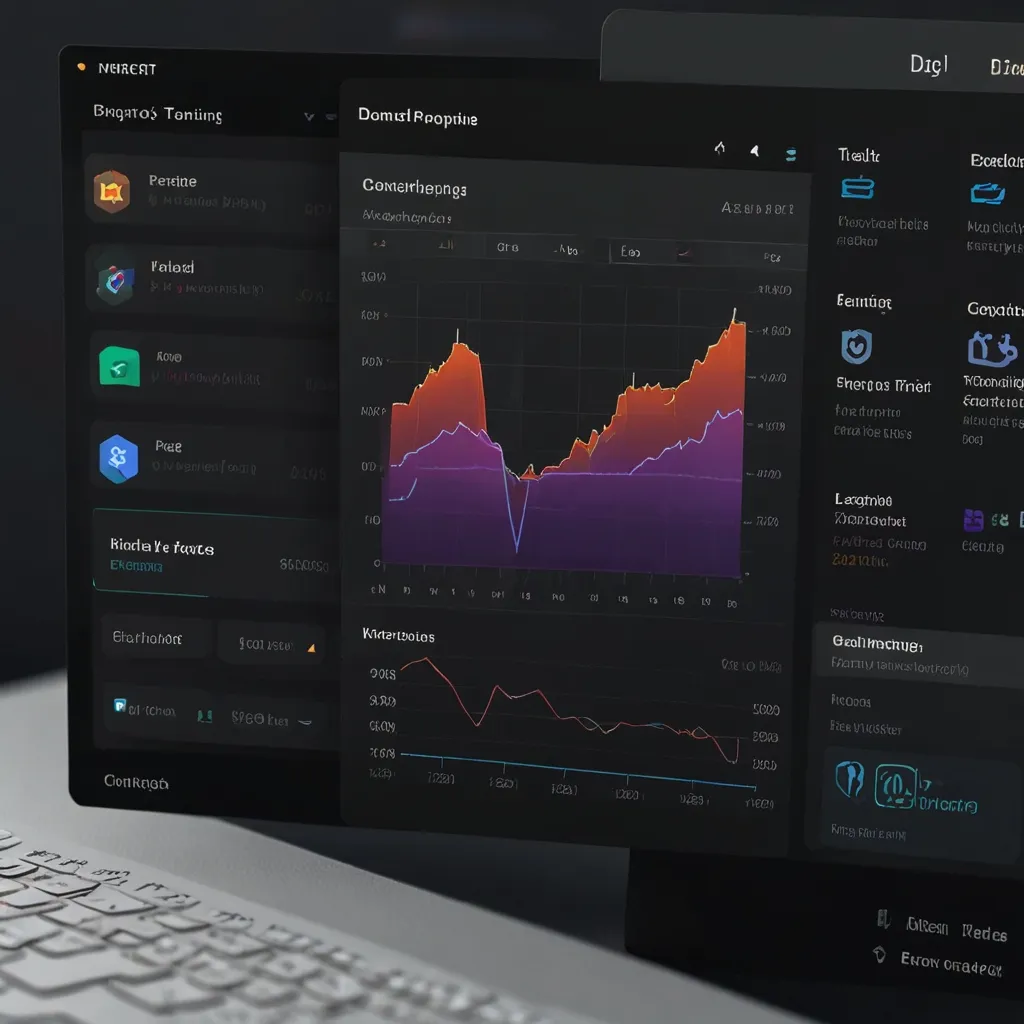As a web developer with years of experience, I’ve seen how the right tools can transform a project from a daunting task into a smooth, efficient process. JavaScript libraries are among the most powerful assets in my toolkit, offering specialized functions that save time and reduce errors. In this article, I’ll walk you through seven libraries I consistently use for modern web development, sharing insights and code examples that have proven invaluable in real-world applications. Each library addresses specific challenges, from data manipulation to animations, and I’ll explain why they stand out in today’s fast-paced development landscape.
When I first started working with JavaScript, handling arrays and objects felt cumbersome without helper functions. That’s where Lodash comes in—it’s a utility library that simplifies common programming tasks with a consistent API. I often use it for tasks like debouncing user inputs or creating deep copies of objects, which avoids unintended side effects. Its modular design means I can import only the functions I need, keeping my bundle size lean. For instance, in a recent project, I used Lodash to group data by categories, making it easier to display organized lists without writing complex loops.
// Practical Lodash usage in a search feature
import { debounce, sortBy, uniq } from 'lodash';
const searchInput = document.getElementById('search');
const resultsDiv = document.getElementById('results');
// Debounce search to avoid excessive API calls
const handleSearch = debounce(async (query) => {
const response = await fetch(`/api/items?q=${query}`);
const items = await response.json();
const sortedItems = sortBy(items, 'name');
const uniqueItems = uniq(sortedItems);
displayResults(uniqueItems);
}, 300);
searchInput.addEventListener('input', (e) => handleSearch(e.target.value));
function displayResults(items) {
resultsDiv.innerHTML = items.map(item => `<div>${item.name}</div>`).join('');
}
Another library I rely on daily is Axios, a promise-based HTTP client that handles requests with ease. In my early projects, I struggled with inconsistent browser support for fetch, but Axios provides a uniform interface across environments. I appreciate its built-in features like automatic JSON parsing and request cancellation, which are crucial for responsive applications. For example, in a dashboard I built, Axios managed multiple API calls simultaneously, and its interceptors allowed me to add authentication tokens seamlessly without cluttering the main code.
// Axios setup with interceptors for global error handling
import axios from 'axios';
const apiClient = axios.create({
baseURL: 'https://jsonplaceholder.typicode.com',
headers: { 'Content-Type': 'application/json' }
});
// Add a request interceptor to include auth tokens
apiClient.interceptors.request.use(
(config) => {
const token = localStorage.getItem('authToken');
if (token) {
config.headers.Authorization = `Bearer ${token}`;
}
return config;
},
(error) => Promise.reject(error)
);
// Response interceptor for handling errors globally
apiClient.interceptors.response.use(
(response) => response,
(error) => {
if (error.response.status === 401) {
console.log('Redirecting to login...');
window.location.href = '/login';
}
return Promise.reject(error);
}
);
// Using Axios in a component
async function fetchPosts() {
try {
const response = await apiClient.get('/posts');
return response.data;
} catch (error) {
console.error('Failed to fetch posts:', error);
throw error;
}
}
Working with dates in JavaScript used to be a headache until I discovered date-fns. This library offers a straightforward way to parse, format, and manipulate dates without the quirks of native Date objects. I’ve used it in scheduling apps to calculate deadlines and display user-friendly formats. Its functions are immutable, meaning they don’t alter original dates, which prevents bugs in complex applications. In one instance, I integrated date-fns to handle time zones and daylight saving adjustments, ensuring accuracy across regions.
// date-fns for handling complex date scenarios
import { format, parseISO, addBusinessDays, differenceInDays } from 'date-fns';
const eventDate = parseISO('2023-12-25T10:00:00Z');
const formattedDate = format(eventDate, 'MMMM do, yyyy'); // December 25th, 2023
// Calculate business days excluding weekends
const deadline = addBusinessDays(new Date(), 5);
console.log(`Submit by: ${format(deadline, 'MM/dd/yyyy')}`);
// Find days between two dates for a countdown
const start = new Date();
const end = parseISO('2024-01-01');
const daysLeft = differenceInDays(end, start);
console.log(`${daysLeft} days until the new year!`);
For data visualization, Chart.js has been my go-to library for creating interactive charts with minimal effort. I’ve embedded it in reports to display trends and metrics, and its responsive design adapts to different screen sizes. The declarative API lets me define chart options in a clean object structure, and updates are handled smoothly. In a recent financial app, I used Chart.js to render real-time line charts that updated as new data streamed in, providing users with instant insights.
// Chart.js for dynamic data updates
import Chart from 'chart.js/auto';
const salesData = {
labels: ['Q1', 'Q2', 'Q3', 'Q4'],
datasets: [{
label: 'Sales',
data: [65000, 59000, 80000, 81000],
borderColor: '#36A2EB',
backgroundColor: 'rgba(54, 162, 235, 0.2)'
}]
};
const config = {
type: 'line',
data: salesData,
options: {
responsive: true,
plugins: {
legend: { position: 'top' }
}
}
};
const salesChart = new Chart(document.getElementById('chart'), config);
// Simulate real-time data updates
setInterval(() => {
const newData = Math.floor(Math.random() * 10000);
salesData.datasets[0].data.push(newData);
salesData.labels.push(`Q${salesData.labels.length + 1}`);
salesChart.update();
}, 5000);
When I need more control over visualizations, D3.js is my choice for building custom, data-driven graphics. It has a steep learning curve, but the payoff is worth it—I’ve created unique charts and interactive maps that standard libraries couldn’t handle. D3 works by binding data to DOM elements, allowing dynamic updates. In a project analyzing social media trends, I used D3 to draw a force-directed graph that visualized connections between users, with nodes responding to mouse interactions.
// D3.js for a custom interactive visualization
import * as d3 from 'd3';
const dataset = [10, 20, 30, 40, 50];
const svg = d3.select('body').append('svg')
.attr('width', 400)
.attr('height', 200);
// Create bars based on data
svg.selectAll('rect')
.data(dataset)
.enter()
.append('rect')
.attr('x', (d, i) => i * 60)
.attr('y', d => 150 - d)
.attr('width', 50)
.attr('height', d => d)
.attr('fill', 'steelblue')
.on('mouseover', function() {
d3.select(this).attr('fill', 'orange');
})
.on('mouseout', function() {
d3.select(this).attr('fill', 'steelblue');
});
// Add labels
svg.selectAll('text')
.data(dataset)
.enter()
.append('text')
.text(d => d)
.attr('x', (d, i) => i * 60 + 25)
.attr('y', d => 150 - d - 5)
.attr('text-anchor', 'middle')
.attr('fill', 'white');
Ramda introduced me to functional programming in JavaScript, emphasizing pure functions and immutability. I use it for data transformations where composition and currying make code more readable and testable. In an e-commerce app, Ramda helped me filter and sort product lists without mutating the original data. Its functions automatically curry, allowing partial application, which I’ve leveraged to create reusable query builders.
// Ramda for functional data processing
import { pipe, filter, map, sortBy, prop } from 'ramda';
const products = [
{ id: 1, name: 'Laptop', price: 1000, category: 'electronics' },
{ id: 2, name: 'Chair', price: 150, category: 'furniture' },
{ id: 3, name: 'Phone', price: 800, category: 'electronics' }
];
// Compose functions to get sorted electronic products
const getElectronicProducts = pipe(
filter(product => product.category === 'electronics'),
sortBy(prop('price')),
map(product => `${product.name}: $${product.price}`)
);
console.log(getElectronicProducts(products)); // ['Phone: $800', 'Laptop: $1000']
// Currying example for reusability
const discountPrice = (discount, price) => price - (price * discount);
const applyDiscount = discountPrice(0.1); // 10% discount
const updatedProducts = map(product => ({
...product,
price: applyDiscount(product.price)
}), products);
For animations, GSAP delivers smooth, high-performance results that enhance user experience. I’ve used it to animate page transitions, scroll effects, and interactive elements. Its timeline feature lets me sequence animations precisely, and hardware acceleration ensures they run smoothly even on lower-end devices. In a portfolio site, GSAP powered a storytelling section where elements faded and moved in sync with the user’s scroll, creating an immersive narrative.
// GSAP for complex animation sequences
import { gsap } from 'gsap';
import { ScrollTrigger } from 'gsap/ScrollTrigger';
gsap.registerPlugin(ScrollTrigger);
// Animate elements on scroll
gsap.to('.hero-image', {
scrollTrigger: {
trigger: '.hero-section',
start: 'top center',
end: 'bottom center',
scrub: true
},
y: -100,
opacity: 0.5,
duration: 2
});
// Staggered animation for a list
gsap.from('.list-item', {
duration: 1,
y: 50,
opacity: 0,
stagger: 0.2,
ease: 'back.out(1.5)'
});
// Timeline for coordinated animations
const tl = gsap.timeline();
tl.to('.box', { x: 200, rotation: 90, duration: 1 })
.to('.circle', { y: -50, duration: 0.5 }, '-=0.5') // Overlap with previous animation
.from('.text', { opacity: 0, duration: 0.8 });
Choosing the right libraries involves balancing functionality, performance, and maintainability. I always consider factors like bundle size, community support, and how well a library integrates with my existing stack. For example, in performance-critical applications, I might opt for Lodash’s modular imports or GSAP’s optimized animations. It’s also essential to stay updated with library versions to leverage improvements and security patches.
In my journey, I’ve learned that these libraries not only accelerate development but also encourage best practices. They handle edge cases I might overlook, such as timezone issues with dates or cross-browser compatibility with HTTP requests. By incorporating them thoughtfully, I can focus on building unique features rather than reinventing the wheel.
I hope this overview helps you in selecting tools for your projects. Each library has its strengths, and experimenting with them in small prototypes can reveal which ones fit your needs. Remember, the goal is to write clean, efficient code that delivers value to users, and these libraries are trusted companions in that process.






